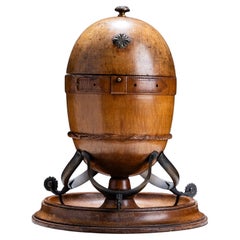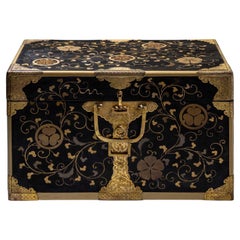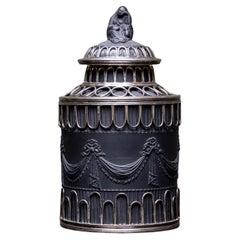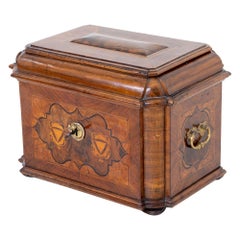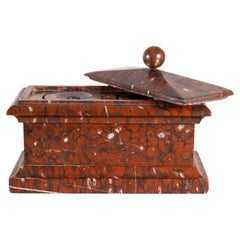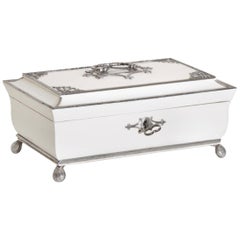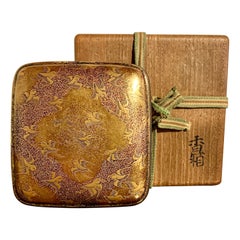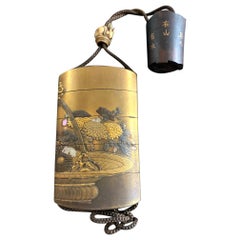EHRL Fine Art and Antiques Boxes
to
3
7
2
5
1
1
5
4
3
1
1
7
5
1
1
1
1
Height
to
Width
to
7
7
7
Egg-Shaped Wooden Box by Maison Alphonse Giroux, Paris, 2nd Half of the 19th C.
By Alphonse Giroux et Cie
Located in Greding, DE
An exquisite egg-shaped wooden box by Maison Alphonse Giroux, crafted in the second half of the 19th century. The box rests on a round base and features metal fittings, including a d...
Category
Antique Late 19th Century French Decorative Boxes
Materials
Metal
Japanese Lacquer Chest, Edo Period
Located in Greding, DE
Small rectangular Japanese chest with gold lacquer decoration in the form of leaf tendrils. The chest is decorated with cut-out and ornamentally engraved fittings on the corners and ...
Category
Antique 18th Century Japanese Edo Decorative Boxes
Materials
Brass
Black Basalt Tea Caddy, 1st half 19th century
Located in Greding, DE
Cylindrical tea caddy made of black basalt with silver mounting and figural nodus.
Category
Antique Early 19th Century European Neoclassical Tea Caddies
Materials
Silver
Baroque Guild Chest, Mid-18th Century
Located in Greding, DE
Baroque guild drawer with side brass handles and domed lid. The body stands on pressed ball feet, has rounded corners and is veneered on all sides in walnut with strapwork marquetry.
Category
Antique Mid-18th Century Baroque Decorative Boxes
Materials
Brass
Marble Case with Inkwell, Italy 2nd Half 19th Century
Located in Greding, DE
Red marble casket with pyramidal lid and fitted brass vessels. Light bumps.
Category
Antique Mid-19th Century Italian Decorative Boxes
Materials
Marble
$2,049 Sale Price
20% Off
Small Jewelry Box, Probably, Vienna, 19th Century
Located in Greding, DE
White lidded box standing on small spherical feet with trapezoidal body and lid with a groove. The fittings are silver plated. Key available. Interior veneered in cherry.
Category
Antique 19th Century Austrian Biedermeier Jewelry Boxes
Materials
Wood
$2,329 Sale Price
20% Off
Tea Chest, Germany First Half of the 19th Century
Located in Greding, DE
Lidded chest with a curved lid and a concave belly, standing on brass ball feet. The escutcheon is inlayed in bone. Mahogany veneered.
Category
Antique Early 19th Century German Biedermeier Tea Caddies
Materials
Brass
$1,677 Sale Price
20% Off
Related Items
Japanese Lacquer Incense Box, Kogo, Momoyama or Edo Period, 16th/17th Century
Located in Austin, TX
A wonderful Japanese lacquer incense box, kogo, with a design of plovers in flight, late Momoyama or early Edo Period, circa 1600, Japan.
The small box, called a kogo, was used to s...
Category
Antique Early 17th Century Japanese Edo Lacquer
Materials
Gold, Pewter
$6,000
H 2.75 in W 3.75 in D 3.75 in
Antique Japanese Inro by Shigehide Edo Period
Located in Atlanta, GA
This exquisite four-case lacquered inro was dated to the latter part of 18th century to early 19th century (Edo period) and made by Shigehide. The opposite sides of the inro together features a lavish flower arrangement in a bamboo basket (ikebana). The detailed craftmanship was a true pleasure to behold. Mostly Takamaki-e (high relief) were used to texturize the delicate petals of the chrysanthemums, on which different shades of gold were used to create contrast. Raden (mother of pearl) shells were also used to highlight some leaves, rendering the piece an interesting balance of color and material. The interior was completed in a mottled gold finish. It was signed Shigehide on the bottom with a Kao. There is a small carved rabbit ojime bead...
Category
Antique Late 18th Century Japanese Japonisme Lacquer
Materials
Wood, Lacquer
Japanese Marquetry and Lacquer Jewelry Chest, Meiji Period, circa 1900, Japan
Located in Austin, TX
A very attractive Japanese wood table top jewelry or collector's chest with marquetry and lacquer decoration, Meiji period, circa 1900, Japan. Previously in the collection of Asbjorn Lunde (1927 - 2017).
The chest is crafted in the form of a Chinese seal...
Category
Antique Early 1900s Japanese Meiji Lacquer
Materials
Wood, Softwood, Lacquer
$3,400
H 15.75 in W 14.25 in D 7 in
Japanese Maki-e Lacquer Stacking Box, Jubako, Meiji Period, Japan
Located in Austin, TX
A fine and impressive Japanese gold maki-e decorated black lacquer five-tier jubako with presentation tray, two lids, and the original tomobako storage box, Meiji period, late 19th c...
Category
Antique Late 19th Century Japanese Meiji Lacquer
Materials
Lacquer
Japanese Momoyama Period Black Lacquer and Mother of Pearl Box, 16th Century
Located in Austin, TX
A fine and unusual Japanese black lacquer and mother of pearl inlaid box, Momoyama Period, 16th century, Japan.
The large box and cover featu...
Category
Antique 16th Century Japanese Edo Lacquer
Materials
Lacquer, Abalone
$9,800
H 4 in W 11 in D 15 in
Beautiful Hermés, Ashtray, 2nd Half of the 20th Century
By Hermès
Located in Madrid, ES
Hermés, ashtray, 2nd half of the 20th century.
Gray horse on a lining crib with gold rim.
Underside covered with gray felt.
Marked on the side: Hermés- P...
Category
20th Century French Modern Desk Sets
Materials
Porcelain
Rare 19th Century Chinoiserie Black Lacquer Tea Caddy, circa 1820
Located in Richmond, London
A very rare English Regency period chinoiserie style black lacquer box, exquisitely gilt-decorated with whimsical oriental motifs.
England, early 19th century.
Why we like it
A cha...
Category
Antique Early 19th Century European Chinoiserie Tea Caddies
Materials
Wood, Lacquer
19th Century Sewing Box by Maison Aucoc, Paris
By A. Aucoc
Located in Paris, FR
Late 19th century oval sewing box decorated with crowned monogram. The case contains five gold and steel sewing utensils embellished with small flowers. Labeled on the inside: AUCOC A PARIS. Weight: 27.6 g,
circa 1860
Dimension: W 4.5 in, D 2.4in, H .8in.
Dimension: L 11.5cm, P 6cm, H 2cm.
La Maison Aucoc...
Category
Antique 19th Century French Napoleon III Decorative Boxes
Materials
Gold, Steel
Antique Anglo-Indian Fluted Writing Box With Secret Drawers. Early 19th Century
Located in St Annes, Lancashire
Wonderful writing box made from a tropical hardwood
Fabulous shape and plain fluted carving. It gives it a modernist appearance
Probably Sri Lankan
3 secret drawers*
Replaced lea...
Category
Antique Early 19th Century Sri Lankan Anglo-Indian Decorative Boxes
Materials
Wood
$650
H 5.5 in W 16 in D 9 in
18th Century Mexican Chest from New Spain
Located in Marbella, ES
Mexican chest. New Spain, 18th century.
In polychrome wood.
Slight paint losses on the lid.
Measurements: 7 x 16 x 6.5 cm.
Wooden chest from the vicerega...
Category
Antique Mid-18th Century Mexican Decorative Boxes
Materials
Wood
Swedish 19th Century Birchwood Veneer Jewelry Box
Located in Haddonfield, NJ
Swedish 19th century birchwood veneer jewelry box.
The box has a heart of brass for keyhole and knob hardware of antler.
Category
Antique 19th Century Swedish Rustic Decorative Boxes
Materials
Bone, Birch
Japanese Rinpa Style Lacquer Box Meiji Period
Located in Atlanta, GA
A black lacquer tebako (hand box) with maki-e decoration and silver trim, circa late 19th century, Meiji period. The surface of the lid features a Rinpa style maki-e paint depicting ...
Category
Antique 1890s Japanese Japonisme Lacquer
Materials
Wood, Lacquer
